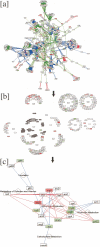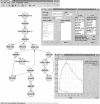Cytoscape: a software environment for integrated models of biomolecular interaction networks - PubMed (original) (raw)
Cytoscape: a software environment for integrated models of biomolecular interaction networks
Paul Shannon et al. Genome Res. 2003 Nov.
Abstract
Cytoscape is an open source software project for integrating biomolecular interaction networks with high-throughput expression data and other molecular states into a unified conceptual framework. Although applicable to any system of molecular components and interactions, Cytoscape is most powerful when used in conjunction with large databases of protein-protein, protein-DNA, and genetic interactions that are increasingly available for humans and model organisms. Cytoscape's software Core provides basic functionality to layout and query the network; to visually integrate the network with expression profiles, phenotypes, and other molecular states; and to link the network to databases of functional annotations. The Core is extensible through a straightforward plug-in architecture, allowing rapid development of additional computational analyses and features. Several case studies of Cytoscape plug-ins are surveyed, including a search for interaction pathways correlating with changes in gene expression, a study of protein complexes involved in cellular recovery to DNA damage, inference of a combined physical/functional interaction network for Halobacterium, and an interface to detailed stochastic/kinetic gene regulatory models.
Figures
Figure 2
Schematic overview of the Cytoscape Core architecture. The Cytoscape window is the primary visual and programmatic interface to Cytoscape and contains the network graph and attribute data structures. Core methods that operate on these structures are graph editing, graph layout, attribute-to-visual mapping, and graph filtering. Annotations are available through a separate server.
Figure 1
Tour of Cytoscape core functionality. (a) Available network layout algorithms are accessed via the menu system; an example hierarchical layout is shown. (b) The data attribute-to-visual mapping control is used to integrate a variety of heterogenous data types on the network. Here, gene expression data are mapped to node color for the condition named “gal80R,” in which color is interpolated between green (negative values) and red (positive values) through gray as the midpoint. Node colors in a are derived using this mapping. (c) Attributes are displayed for selected nodes and edges in a browser window. As shown, multiple attributes and genes may be displayed in a customtabular format. (d) Annotations are transferred to node and edge attributes by choosing the desired ontology and hierarchical level from a list of those available.
Figure 3
Screening DNA-damage phenotypes against a scaffold of molecular interactions. A large molecular interaction network was integrated with 1615 yeast deletion phenotypes gathered systematically in response to MMS exposure. (a) Cytoscape's filter toolbox was first used to show only those proteins required for viable growth in MMS (i.e., MMS-essential proteins) and their immediate network neighbors. (b) The filtered network was then searched using the ActiveModules plug-in to identify interaction complexes containing significant numbers of MMS-essential proteins. One such region is shown, along with its corresponding p-value. Dark gray nodes represent MMS-essential proteins.
Figure 4
Function-guided layout of the Halobacterium inferred protein network facilitates simultaneous exploration of large discrete databases. (a) The largest connected component of the Halobacterium network is shown; red, green, and blue edges indicate phylogenetic interactions, protein-protein interactions inferred from yeast, and domain-fusion events, respectively (see text). Node colors indicate mRNA expression changes in a phototrophy deficient strain relative to the parent, in which red is induced and green is repressed. (b) Attribute-based layout was used to organize the network according to major functional classes. The cluster predominantly involved with amino-acid metabolism is selected for further exploration (shaded nodes), with edges hidden for clarity. (c) A highly connected subnetwork within the amino-acid metabolism cluster reveals the effect of suppression of phototrophy on amino-acid metabolismand highlights interactions with nucleotide metabolism and other pathways.
Figure 5
Cytoscape and the Systems Biology Workbench stochastically simulating gene regulation. In collaboration with the ERATO Systems Biology Workbench (SBW) project (Hucka et al. 2002), we developed a plug-in that allows Cytoscape to read and simulate SBML-encoded biochemical models. A Cytoscape network view of the SBML model is shown (left), accompanied by a user interface to the simulator (top, right) and an x-y plot of stochastic simulation results (bottom, right). In the x-y plot, the top curve shows the concentration of the N protein, which regulates genes expressed early in λ phage life cycle. Details are available at
http://www.cytoscape.org/plugins/SBW/
.
References
- Batagelj, V. and Mrvar, A. 1998. Pajek—Program for large network analysis. Connections 21: 47-57.
- Begley, T.J., Rosenbach, A.S., Ideker, T., and Samson, L.D. 2002. Damage recovery pathways in Saccharomyces cerevisiae revealed by genomic phenotyping and interactome mapping. Mol. Cancer Res. 1: 103-112. - PubMed
- DeRisi, J.L., Iyer, V.R., and Brown, P.O. 1997. Exploring the metabolic and genetic control of gene expression on a genomic scale. Science 278: 680-686. - PubMed
WEB SITE REFERENCES
- http://biodata.mshri.on.ca/; Osprey Network Visualization System
- http://pim.hybrigenics.com/; PIMRider
- http://predictome.bu.edu/; Predictome Project
- http://www.cytoscape.org/; Cytoscape v1.1 Home Page
- http://www.cytoscape.org/plugins/SBW/; Supplementary data on model exchange via SBML
Publication types
MeSH terms
Substances
LinkOut - more resources
Full Text Sources
Other Literature Sources
Molecular Biology Databases




